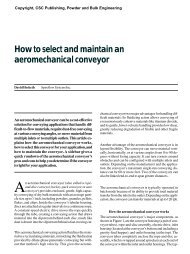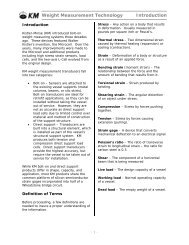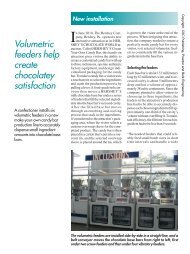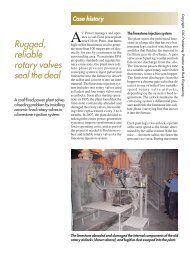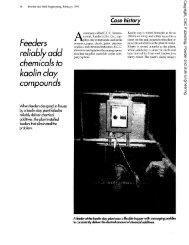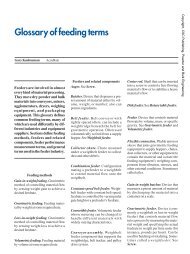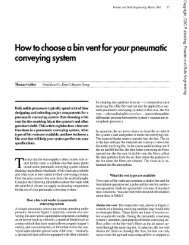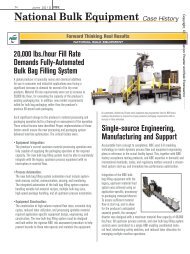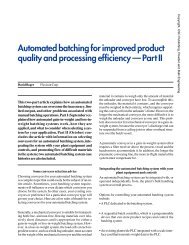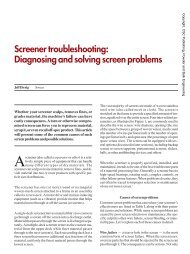Acrison - Powder and Bulk Engineering Magazine
Acrison - Powder and Bulk Engineering Magazine
Acrison - Powder and Bulk Engineering Magazine
You also want an ePaper? Increase the reach of your titles
YUMPU automatically turns print PDFs into web optimized ePapers that Google loves.
Feeders<br />
provide<br />
highly<br />
accurate,<br />
repeatable<br />
feedrates<br />
A toll compounder chooses<br />
durable <strong>and</strong> reliable<br />
loss-in-weight feeders for a<br />
new production line.<br />
New installation<br />
In 2005, R<strong>and</strong>y Rudisill <strong>and</strong> Dave<br />
Donie, both former top executives<br />
of a major plastics company,<br />
founded American Compounding Specialties<br />
(ACS) to toll-compound various<br />
thermoplastics <strong>and</strong> specialty resins<br />
for companies in the plastics <strong>and</strong> chemical<br />
industries. ACS was initially<br />
formed to fill a void in the custom-compounding<br />
market by using advanced<br />
product quality planning (APQP) techniques,<br />
a systematic approach designed<br />
to ensure top-quality products <strong>and</strong> customer<br />
satisfaction. Rudisill <strong>and</strong> Donie,<br />
who have more than 65 years combined<br />
experience working in the plastics industry,<br />
aimed to guarantee their customers<br />
a 99 percent yield rate, which is<br />
considerably higher than the more typical<br />
90 to 93 percent rate, says Donie.<br />
The partners knew that to accomplish<br />
this, the production line for the company’s<br />
new 17,500-square-foot plant in<br />
Fowlerville, Mich., would require accurate<br />
<strong>and</strong> reliable equipment, including<br />
several loss-in-weight (LIW)<br />
weighfeeders.<br />
The toll-compounding production<br />
process<br />
ACS operates 24 hours a day, 7 days a<br />
week, toll-compounding polypropylene,<br />
nylon, polycarbonate, ethylene<br />
vinyl acetate, <strong>and</strong> other products for<br />
its customers. In April 2006, the company<br />
first began operations with one<br />
production line consisting of a twinscrew<br />
extruder, a preblender, two raw<br />
material desiccating dryer-hoppers,<br />
several raw material hoppers, control<br />
panels, a classifier <strong>and</strong> pellet cooler,<br />
packaging equipment, <strong>and</strong> several<br />
feeders to accurately feed powders,<br />
pigments, pellets, fiberglass, liquids,<br />
<strong>and</strong> other materials into the process.<br />
Customer raw materials <strong>and</strong> additives<br />
arrive at the toll-compounding plant<br />
in various containers: <strong>Powder</strong>s are<br />
shipped in bags <strong>and</strong> drums, resin pigments<br />
<strong>and</strong> specialty additives in bags,<br />
resin pellets in gaylords, choppedstr<strong>and</strong><br />
fiberglass in bulk bags, <strong>and</strong><br />
mica, talc, <strong>and</strong> iron ferrite in bulk<br />
bags. The various powders <strong>and</strong> pigments,<br />
which include difficult-flowing<br />
materials, have particle sizes<br />
ranging from 0.5 to 20 microns, the<br />
resin pellets are about 1 ⁄8 inch in size,<br />
<strong>and</strong> the chopped-str<strong>and</strong> fiberglass is<br />
about 4 microns.<br />
Copyright, CSC Publishing, <strong>Powder</strong> <strong>and</strong> <strong>Bulk</strong> <strong>Engineering</strong><br />
To make a product — for example, one<br />
consisting of nylon 6 <strong>and</strong> nylon 6-6 —<br />
The production line’s main feeder (right foreground) has a 20-cubic-footcapacity<br />
stainless steel hopper <strong>and</strong> feeds pellets, powders, <strong>and</strong> pelletpowder<br />
blends at up to 4,000 lb/h.
an operator stages a gaylord of each material<br />
in a box-tipper with a dedicated<br />
bin. Each box-tipper empties the material<br />
from the gaylord into its bin, which<br />
is connected to a dedicated vacuum<br />
conveying system with a 3-inch-diameter<br />
pipe. Each conveying system moves<br />
the material from the bin vertically<br />
about 30 feet, discharging it into a dedicated<br />
500-pound-capacity dryer-hopper.<br />
The two desiccating dryer-hoppers<br />
are located on the second tier of a twotier<br />
mezzanine <strong>and</strong> installed directly<br />
above the 1,000-pound-capacity preblender,<br />
which is installed on the mezzanine’s<br />
first tier. The dryer-hoppers<br />
remove moisture from hygroscopic materials<br />
so that they enter the downstream<br />
process with a known moisture content.<br />
The materials discharge from the<br />
dryer-hoppers into the preblender,<br />
which creates a homogenous blend.<br />
At this stage, the operator can also<br />
add stabilizers, pigments, <strong>and</strong> other<br />
specialty additives if required by the<br />
product formulation. The preblender<br />
also acts as a refill device for the main<br />
feeder, which has a 1,000-pound-capacity<br />
hopper <strong>and</strong> is positioned directly<br />
below the preblender on the<br />
main floor next to the extruder. When<br />
the main feeder’s hopper reaches a<br />
low level, the feeder signals the preblender<br />
to discharge a batch to refill<br />
the hopper. An alarm simultaneously<br />
sounds to alert the operator to make<br />
another blend while the feeder’s hopper<br />
is full. This allows the production<br />
process to operate continuously.<br />
A product formulation can have 15 or<br />
more ingredients, <strong>and</strong> the LIW weighfeeders<br />
are used throughout the production<br />
line to meter the various<br />
materials into the twin-screw extruder.<br />
The main feeder feeds pellets, powders,<br />
<strong>and</strong> pellet-powder blends into<br />
the extruder, which heats up the materials<br />
<strong>and</strong> melts <strong>and</strong> mixes everything<br />
together. Two secondary feeders add<br />
minor <strong>and</strong> specialty ingredients such<br />
as fiberglass <strong>and</strong> talc. And liquid ingredients<br />
are added by a liquid LIW<br />
feeder with a metering pump.<br />
After passing through the extruder, the<br />
molten product discharges to the<br />
downstream process where it’s<br />
shaped, cooled, dried, pelletized, classified,<br />
<strong>and</strong> finally packaged for shipment<br />
to the customer. During each<br />
production run, ACS conducts inprocess<br />
testing to ensure quality <strong>and</strong><br />
guarantee the customer a high-quality,<br />
high-yield product every time.<br />
Selecting the feeders<br />
According to Donie, when he <strong>and</strong> Rudisill<br />
were planning to start ACS, they<br />
knew that the production line’s feeders<br />
would be supplied by <strong>Acrison</strong> Inc.<br />
The Moonachie, N.J., company supplies<br />
dry solids metering <strong>and</strong> han-<br />
A product formulation can have 15<br />
or more ingredients, <strong>and</strong> the LIW<br />
weighfeeders are used throughout<br />
the production line to meter the<br />
various materials into the twinscrew<br />
extruder.<br />
Copyright, CSC Publishing, <strong>Powder</strong> <strong>and</strong> <strong>Bulk</strong> <strong>Engineering</strong><br />
The production line’s secondary feeder (right background) has a 6-cubicfoot-capacity<br />
stainless steel hopper <strong>and</strong> feeds calcium carbonate, fiberglass,<br />
<strong>and</strong> other specialty additives at up to 2,000 lb/h.
dling equipment <strong>and</strong> systems, including<br />
weighfeeders, volumetric feeders,<br />
multifeeder controllers, <strong>and</strong> controls<br />
systems. “I’ve worked with the supplier<br />
a lot in the past <strong>and</strong>, in my opinion,<br />
they have the best feeders on the<br />
market,” says Donie. “That’s why we<br />
specified their feeders from the very<br />
beginning. We needed feeders that are<br />
easy to clean between product runs<br />
<strong>and</strong> are able to h<strong>and</strong>le a wide range of<br />
dry solid materials, from difficult-toh<strong>and</strong>le<br />
powders <strong>and</strong> fibers to pellets<br />
<strong>and</strong> flakes. The supplier’s feeders do<br />
that. They’re also reliable <strong>and</strong><br />
durable, which was essential.”<br />
Donie says that an improperly functioning<br />
feeder is one of many things<br />
that can cause material waste, which<br />
decreases product yield rates <strong>and</strong> increases<br />
customer costs. For example,<br />
if a feeder’s feedrate varies even a little,<br />
it can destabilize the process so<br />
that it produces a poor-quality product,<br />
or scrap, which decreases yield<br />
rates. Or, if a feeder deviates too<br />
much, the production line will shut<br />
down, “which also produces scrap<br />
<strong>and</strong> raises a customer’s costs,” says<br />
Donie, “because we have to purge<br />
about three hundred pounds of product<br />
before restarting the line. So the<br />
accuracy, reliability, <strong>and</strong> repeatability<br />
of the supplier’s feeders help us keep<br />
yield rates high <strong>and</strong> customer costs<br />
low by eliminating such problems.”<br />
The feeders<br />
ACS’s production line includes three<br />
LIW weighfeeders, <strong>and</strong> one volumetric<br />
feeder. The LIW feeders use a nonload-cell<br />
platform weighing system<br />
with a split-beam lever weighing network.<br />
With this system, the feeder’s<br />
hopper <strong>and</strong> ancillary equipment are<br />
mounted on a platform that sits on the<br />
weighing mechanism. The weighing<br />
system uses the supplier’s Ratiometric<br />
Digital Weight Resolver Weight<br />
Sensing System with synchro-resolver<br />
technology to provide ultrahigh-resolution<br />
weight sensing <strong>and</strong><br />
precise weighing accuracy. Each LIW<br />
feeder’s weighing system, which is<br />
calibration- <strong>and</strong> adjustment-free,<br />
monitors a hopper’s weight numerous<br />
times per second to ensure a feeding<br />
accuracy of ±0.25 to ±1.0 percent at 2<br />
sigma for every 1-minute interval.<br />
The production line’s main feeder is a<br />
model 404X-170-3 LIW weighfeeder<br />
that has a 20-cubic-foot-capacity stainless<br />
steel hopper with a bolted access<br />
door. The feeder’s 1.5-horsepower<br />
variable-speed motor drives a solidflight<br />
stainless steel feed auger <strong>and</strong> can<br />
feed pellets, powders, <strong>and</strong> pellet-powder<br />
blends with up to 10 percent powder<br />
at 3,000 to 4,000 lb/h. The feed<br />
auger has a special release-coating on<br />
it to improve feeding accuracy. A 1.5-<br />
horsepower single-speed motor drives<br />
the hopper’s conditioning agitator<br />
auger, located in the hopper bottom, to<br />
ensure positive material flow out of the<br />
hopper <strong>and</strong> directly into the feed chamber.<br />
The feeder is mounted on casters<br />
<strong>and</strong> is 42 inches wide, 78 inches long,<br />
<strong>and</strong> 83 inches tall with the hopper.<br />
The line’s two secondary feeders are<br />
model 402-170-1 LIW weighfeeders,<br />
<strong>and</strong> each has a 6-cubic-foot-capacity<br />
stainless steel hopper. Each feeder’s<br />
0.5-horsepower variable-speed motor<br />
drives a helical feed auger <strong>and</strong> can feed<br />
calcium carbonate, fiberglass, <strong>and</strong><br />
other specialty additives at 1,000 to<br />
2,000 lb/h. A 0.75-horsepower singlespeed<br />
motor drives each feeder’s conditioning<br />
agitator auger. These feeders<br />
are also mounted on casters, <strong>and</strong> each<br />
is 26 inches wide, 49 inches long, <strong>and</strong><br />
66 inches tall with the hopper.<br />
The line’s stationary refill device is a<br />
model 130-2 volumetric feeder with a<br />
20-cubic-foot-capacity hopper <strong>and</strong> a<br />
downspout with a slide-gate valve<br />
mounted on the discharge end of the<br />
feed auger. The feeder’s 3-horsepower<br />
single-speed motor drives an<br />
8-inch-diameter solid-flight feed<br />
auger <strong>and</strong> can feed materials at 300 to<br />
1,000 lb/h. The feeder is dedicated to<br />
refilling one secondary feeder’s hopper<br />
with 5.6 cubic feet of mica, talc, or<br />
other additive about 4 to 6 times an<br />
hour when operating.<br />
The toll compounder’s two production<br />
lines annually produce<br />
more than 60 million pounds of<br />
thermoplastic <strong>and</strong> specialty resin<br />
products.<br />
Exp<strong>and</strong>ing production capacity<br />
In summer 2007, after 1 year of successful<br />
operations, ACS decided to install<br />
a second production line to increase<br />
the plant’s annual production capacity<br />
from 30 million to 60 million pounds.<br />
For the second production line, a mirror<br />
of the first, Donie again specified that<br />
the supplier’s feeders be used to feed the<br />
various materials into the process.<br />
During the 2007 production line expansion,<br />
ACS also installed the supplier’s<br />
recently developed monitoring <strong>and</strong> control<br />
system <strong>and</strong> connected it to each<br />
feeder’s SBC 2000 weighfeeder controller<br />
to better manage the production<br />
process. The supplier’s AcriData Windows-based<br />
supervisory software program<br />
is installed on the company’s<br />
central PC, which is connected to each<br />
feeder’s controller via field wiring. This<br />
allows ACS to collect data from each<br />
production run, store it in a database,<br />
<strong>and</strong> track every aspect of the production<br />
process.<br />
“The monitoring <strong>and</strong> control system<br />
also has a recipe system,” says Donie,<br />
“so when I go to make a product, I just<br />
access the database, pull up the product’s<br />
formulation, <strong>and</strong> hit Enter. The<br />
system then automatically configures<br />
the feeders to the correct operating parameters,<br />
eliminating the need to manually<br />
configure each feeder individually.”<br />
Copyright, CSC Publishing, <strong>Powder</strong> <strong>and</strong> <strong>Bulk</strong> <strong>Engineering</strong>
Feeders contribute to company’s<br />
success<br />
Since ACS began operations, the supplier’s<br />
feeders have contributed to the<br />
company’s ability to consistently produce<br />
high-quality products <strong>and</strong> high<br />
yield rates while meeting the ongoing<br />
needs of its ever-exp<strong>and</strong>ing customer<br />
base. “The supplier’s feeders are the<br />
best fit for our production process because<br />
of their reliability <strong>and</strong> feeding<br />
accuracy,” says Donie. “Over the<br />
years, I’ve probably purchased more<br />
than two hundred of the supplier’s<br />
feeders for various production lines.<br />
And even though the feeder’s initial<br />
cost is a little more than others on the<br />
market, once you buy one you’re done<br />
spending money because they don’t<br />
break down like other, cheaper feeders<br />
do. They’re sturdy <strong>and</strong> robust <strong>and</strong><br />
don’t need a lot of maintenance.”<br />
The few maintenance issues that have<br />
occurred with the supplier’s feeders<br />
have been minor <strong>and</strong> easily resolved,<br />
typically over the phone. “The problems<br />
we’ve had with the feeders have<br />
mainly been self-inflicted, like installing<br />
the feed auger wrong, or<br />
minor, like a motor controller board or<br />
CPU card going bad,” says Donie.<br />
“But those are easy fixes since I keep a<br />
few spare motor controller boards <strong>and</strong><br />
CPU cards on h<strong>and</strong> for such occasions.<br />
However, if a problem occurs<br />
that we can’t readily fix, the supplier<br />
has a hotline that we can call any time<br />
twenty-four hours a day <strong>and</strong> either get<br />
someone on the phone immediately or<br />
have someone call back within twenty<br />
minutes to help fix the problem. So far,<br />
they’ve always been able to walk us<br />
through the problem over the phone<br />
<strong>and</strong>, if a part is needed, overnight it.”<br />
According to Donie, the supplier has<br />
always been responsive to ACS’s<br />
needs. “They’re organized <strong>and</strong> have a<br />
systematic way of doing things that<br />
ensures things get done right the first<br />
time,” he says. “They give you exactly<br />
what they say they’re going to give<br />
you; there are no mistakes.”<br />
ACS’s success, due in part to the supplier’s<br />
feeders, has enabled it to continue<br />
to exp<strong>and</strong> its operations. “We recently<br />
purchased a small feeder from<br />
the supplier that we’re going to add to<br />
the first production line,” says Donie.<br />
“We’re also getting ready to break<br />
ground on a new addition that will<br />
double the size of our plant <strong>and</strong> allow<br />
us to put in more production lines <strong>and</strong><br />
increase our annual production capacity<br />
to one hundred million pounds<br />
some time next year. We’re going to<br />
be installing the supplier’s feeders<br />
<strong>and</strong> control systems in those new production<br />
lines.”<br />
PBE<br />
Note: To find other articles on this<br />
topic, look under “Feeders” in <strong>Powder</strong><br />
<strong>and</strong> <strong>Bulk</strong> <strong>Engineering</strong>’s Article<br />
Index at www.powderbulk.com or in<br />
the December 2008 issue.<br />
<strong>Acrison</strong>, Moonachie, NJ<br />
201-440-8300<br />
www.acrison.com<br />
Copyright, CSC Publishing, <strong>Powder</strong> <strong>and</strong> <strong>Bulk</strong> <strong>Engineering</strong>





